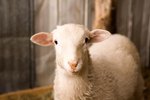Goats give birth approximately 145 to 155 days after conception (the average depends on the specific breed of the goat). When a female goat, referred to as a doe, gives birth it is called "kidding". Goats can have up to six kids during a kidding, although this is pretty uncommon. Most of the time a goat will give birth to two kids, although one kid or three kids happens roughly as often.
Before Birth
While not all goats show birthing signs, there are some common things to look for before your doe gives birth. About a week before the projected due date, you should start keeping track of your doe. The mucus plug (a creamy white bit of stuff that looks like gelatin) will come out of her vulva at some point before the labor, but that's not a definite sign of when labor will start. A stream of mucus discharging from the vulva is a sign labor could be near. Sometimes does get restless or try to dig a nest. They may try to leave and go off by themselves. If she kids outside in the rain, or some place you can't get to the kids, they may become sick.
During Birth
A female goat can give birth standing or sitting. When the doe has contractions, it will arch its back and lift its tail. The doe may vocalize during particularly hard or rough contractions. First, a "bubble" will appear. This is the beginning of the amniotic sac and some of the fluid that is contained therein. After a few pushes the kid will begin to show -- generally you will see the tips of feet and then the tip of its nose first. The rest of the body, followed by the kid's back legs will then emerge, generally in one swift moment after the shoulders emerge. The doe will start to clean the kid.
Breech and Other Problems
The most common birthing position is front feet followed by head. Another common position is back feet followed by body. Both of these positions are fine, as the feet clear before the rest of the goat. In births where both feet do not present themselves, you may have to push the kid back in and rearrange its limbs so that it comes out feet first. Also, if the head gets bent backwards, you will have to rearrange the head so that it comes out behind the front feet. This can get complicated when dealing with multiple births, as the kids can tangle up in each other.
After Birth
Within hours of the birth, kids will be up and walking around. In the weeks following, the doe's body begins to prioritize making milk, so the mother will begin to lose some of the weight that it gained during the course of the pregnancy. This is normal, and is nothing to be concerned about, provided you know that the doe is getting adequate feed. If the doe or kid seem to sicken in the week that follows the birth, call your vet.
References
Photo Credits
-
Jupiterimages/Photos.com/Getty Images
Writer Bio
Leigh Kramer has been a freelance writer since 2009. She has authored training materials for local companies and draws on years of crafting experience to write articles for online publications, as well. Kramer is pursuing a degree in electrical engineering from the University of Oklahoma.




